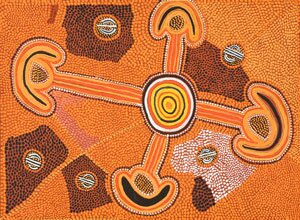CULTURE- ART FEATURE- Dot matrix: Modern dreaming in Aboriginal art

Mick Namarari Tjapaltjarri, Family Moon Dreaming
In Charlottesville's recently roiled art world, here's a bit of good news: John Kluge, benefactor extraordinaire, has decided to donate 16 more paintings to the Kluge-Ruhe Aboriginal Art Collection. Valued at over $1 million, the pivotal works are currently on view in the exhibition, "Virtuosity: The Evolution of Painting at Pupunya Tula."
Curated by New York University anthropologist Fred R. Myers, the show explores how several men living in Papunya Tula, an Australian government settlement for Western Desert Aborigines, developed the tradition now known as "dot painting" using Western tools supplied by a white art teacher in 1971. The two-dimensional pointillist works they created are the seeds that blossomed into the modern Aboriginal art movement.
Prior to 1971, Aboriginal visual expression was transient and utilitarian. Those who possessed the required depth of knowledge drew spiritually significant designs on rocks, traced them in sand, or painted them on religious objects, including the human body. When art teacher Geoff Bardon came to Papunya Tula, he introduced the men to acrylic paints— a seemingly insignificant gesture that led to the evolution of a new way to convey knowledge of "the Dreaming," Aborgines' elaborate cosmology.
The current exhibition showcases five artists seminal to this movement, examining how each— while sharing ideas with the others— developed a distinct style for telling the ancestral stories significant to him. For instance, the serpentine lines that characteristically divide the dot-layered canvases of Johnny Warangkula Tjupurrula capture the post-rain desert landscape central to his "Water Dreaming" paintings.
Another example is the way Yanyatjarri Tjakamarra, whose work focuses on ritual, subtly varies the dots in his large canvases' concentric circles— each representing a sacred site— to create a shimmering effect reminiscent of the way traditional body-painted designs look in firelight.
The show concludes with a roomful of paintings demonstrating how the movement has evolved through a new generation. Of the works displayed, Ronnie Tjampitjinpa's "Nyinmi" is particularly striking with its complexly balanced yellow, blue, red, and black composition. Also included are several works by women, who began painting in the 1990s.
To further bring into focus the circumstances surrounding the original Papunya Tula movement, the Kluge-Ruhe is also screening a 19-minute loop of archival footage from 1974, documenting among other things white art collectors haggling with artists. A particularly poignant sequence records several of the painters traveling into the desert to re-visit their estranged "country."
For the Papunya Tula artists, the ancestral home was where the art is.
The exhibition, "Virtuosity: The Evolution of Painting at Papunya Tula," is on view through August 9 at the Kluge-Ruhe Aboriginal Art Collection. 400 Worrell Dr. (Pantops.) 244-0234.
#